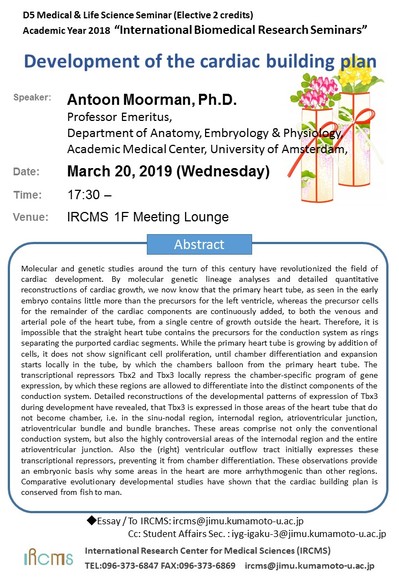- HOME
- News & Events
- [March 20]*D5 Medical & Life Science Seminar*
News & Events
[March 20]*D5 Medical & Life Science Seminar*
February 12 2019
The "D5 Medical & Life Science Seminar" course will be offered by International Research Center for Medical Sciences (IRCMS). It will run from May 2018 to March 2019, with lectures given by scientists affiliated or collaborated with the IRCMS. The course theme for this academic year is "Basic research for understanding disease mechanisms". The lectures will be given once a month, in English, and by leading scientists in the relevant research field. Students will be taught: 1) how normal physiological functions are maintained in human hematopoietic, vascular, immune, reproductive and nervous tissues and organs; 2) how abnormalities in these systems (e.g., cancer) are studied using experimental models; 3) cutting-edge technologies (including single cell level imaging and omics analysis) used for mechanistic understanding of these abnormalities; 4) efforts and progresses in finding cure for human diseases associated with these abnormalities; and 5) importance of understanding disease mechanisms using
Date : March 20, 2019 (Wed)
Time : 17:30 -
Venue : IRCMS 1F Meeting Lounge
Speaker : Antoon Moorman,Ph.D.
Title :Development of the cardiac building plan
Abstract :
Molecular and genetic studies around the turn of this century have revolutionized the field of cardiac development. By molecular genetic lineage analyses and detailed quantitative reconstructions of cardiac growth, we now know that the primary heart tube, as seen in the early embryo contains little more than the precursors for the left ventricle, whereas the precursor cells for the remainder of the cardiac components are continuously added, to both the venous and arterial pole of the heart tube, from a single centre of growth outside the heart. Therefore, it is impossible that the straight heart tube contains the precursors for the conduction system as rings separating the purported cardiac segments. While the primary heart tube is growing by addition of cells, it does not show significant cell proliferation, until chamber differentiation and expansion starts locally in the tube, by which the chambers balloon from the primary heart tube. The transcriptional repressors Tbx2 and Tbx3 locally repress the chamber-specific program of gene expression, by which these regions are allowed to differentiate into the distinct components of the conduction system. Detailed reconstructions of the developmental patterns of expression of Tbx3 during development have revealed, that Tbx3 is expressed in those areas of the heart tube that do not become chamber, i.e. in the sinu-nodal region, internodal region, atrioventricular junction, atrioventricular bundle and bundle branches. These areas comprise not only the conventional conduction system, but also the highly controversial areas of the internodal region and the entire atrioventricular junction. Also the (right) ventricular outflow tract initially expresses these transcriptional repressors, preventing it from chamber differentiation. These observations provide an embryonic basis why some areas in the heart are more arrhythmogenic than other regions. Comparative evolutionary developmental studies have shown that the cardiac building plan is conserved from fish to man.
